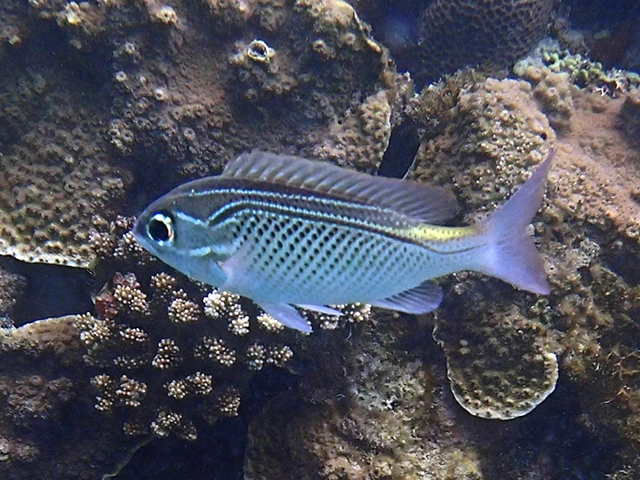
Scolopsis – Various Species
Unfortunately, there isn’t a lot of information or literature on the Scolopsis. I’ll do my best to inform you about the animals we know a little bit about…
There are currently 19 species about which we know something. I’ll now go over the four most well-known Scolopsis.
Of course, each Scolopsis was discovered at a different time and by a different group of (natural) scientists. These names and dates are also mentioned in articles about the species they discovered.
This Terrifying Worm Snatches Fish from the Ocean Floor
Some underwater creatures get too close to the Bobbit Worm’s hidden spot. The sequel is to be guessed.
Within a split second, the Bobbit grasps the animal and tears it down into its burrow.
Slipping sand marks the entrance of the burrow.
Taxonomy
- To begin with: the Scolopsis is a member of the animal kingdom.
- to the Chordata tribe in particular
- The Actinopterygii class (ray fins),
- underclass Neopterygii (new finned),
- infraclass Teleostei (bony fish),
- superorder Acanthopterygii (spiny fins),
- order of Perciformes (perch-like),
- suborder Percoidei (perch), and
- family Nemipteridae (fake snappers).
In the first place: Photos and explanation of the known, and described species of Scolopsis
Firstly: Scolopsis affinis (Peters’ monocle Bream) (Peters, 1877)

(Rickard Zerpe, CC BY 2.0 https://creativecommons.org/licenses/by/2.0, via Wikimedia Commons)
Here I will let you know some synonyms for this fish.
Here are a few Latin names: Scolopsides personatus and Scolopsis personatus.
Do you want to know some interesting facts?
In some cases, this fish likes nothing more than to annoy the “Bobbit worm”.
The animal searches for the entrance to the worm’s lair with zeal then hangs vertically above it with its snout pointing at the opening.
The teasing “Peter’s monocle bream” blows sharp jets of water at their most dangerous enemy as soon as the “Bobbit” appears.

(Xanth Huang, CC BY-SA 2.0 https://creativecommons.org/licenses/by-sa/2.0, via Wikimedia Commons)
I also give you a short description.
- The body of the Scolopsis affinis is silvery white, with a dusky gray head and snout.
- A blue stripe can be seen between the eyes as well.
- A white stripe also runs from the center of the upper lip to below the eye.
- In contrast to the young animals, which are yellowish in color with a dark brown center stripe on the side.
- The average length is 15 cm, while the maximum length is 24 cm.
Next, there are some names from all over the world.
- Australia: Bridled monocle bream, Large-eyed spinecheek, Peters’ monocle bream, Yellow-tail spinecheek
- China: 乌面赤尾冬, 彼氏眶棘鱸, 彼氏眶棘鲈, 红尾冬
- France: Scolopsis de Peter
- Indonesia: Yellow-tail spinecheek
- Malaysia: Batu, Beliak mata, Bulat, Geretak lantai, Kerisi, Mempasir, Mentimun, Monocle bream, Pasir-pasir, Pasir-pasir jalur perang, Peters’ monocle bream, Pijat-pijat, Puyu laut, Timun
- Micronesia: Spinecheek
- Philippines: Bumba, Buruba, Letekan, Peter’s monocle bream, Pugapu, Silay, Sili, Tagisang lawin, Taragaw
- Solomon Is.: Bubukele, Pale monocle bream
- Taiwan: 烏面赤尾冬
- Viet Nam: Cá Lượng dơi
I am going to show you some pictures here.

Rickard Zerpe, CC BY 2.0 https://creativecommons.org/licenses/by/2.0, via Wikimedia Commons

A Bridled Monocle Bream, Scolopsis affinis, in Bali, Indonesia.
Source: Robert Fenner / Wet Web Media https://www.wetwebmedia.com/. License: All rights reserved
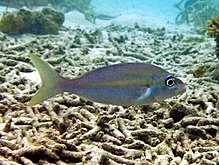
Further, this fish can be found in :
- First, in the western Pacific Ocean, in the Andaman Sea.
- Second, Indonesia is located in the eastern part of the Indian Ocean.
- Finally, head north to the Ryukyu Islands.
- Fourth, there is southern to northeastern Australia, as well as the Solomon Islands.
- These fish appear to prefer sandy (or muddy) bottoms and inhabit reefs.
- They can also be found in protected lagoons.
- At depths of more than 15 meters, the Scolopsis affinis lives alone or in small groups.
- Juveniles, on the other hand, can only be found in sheltered coastal habitats.
These animals can be found in the following fantastic countries:
- Asia: Brunei Darsm, Cambodia, China, Hong Kong, Indonesia, Japan, Macau, Malaysia, Philippines, Ryukyu Is., Singapore, Taiwan, Thailand, Timor-Leste, Viet Nam
- Oceania: Australia, Micronesia, New Caledonia, Palau, Papua New Guinea, Solomon Is.
But what do they eat?
Also important: maybe you want to know what they eat?
First and foremost, their diet is comprised of smaller fish and benthic invertebrates.
In the meantime, how do those fish mate?
When it comes time to mate, these beautiful fish have sexual reproduction.
So, do you think people eat this fish like this?
Because there aren’t many details about this fish, I’m not sure if people eat it.
And, of course, they have a few enemies.
Also: similar to most worms, this Bobbit worm (Eunice aphroditois) lives beneath the soil and can grow up to 3 meters in length.
In the first place, the animal hunts at night from the top of its burrow, where its antennae protrude just above the opening.
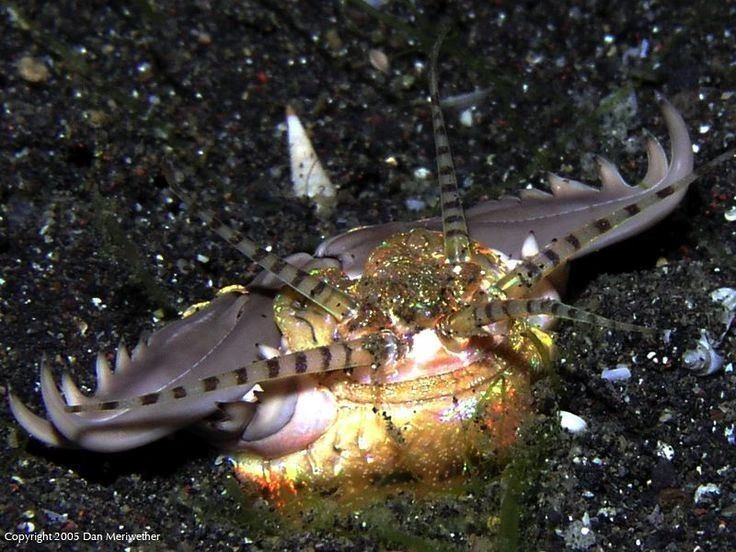
It buries itself in the bottom of the sea where it waits patiently for a fish
- While the smaller fish don’t stand a chance, a larger Scolopsis affinis loves to challenge that predator.
- In fact, the animal is kind enough to warn the other fish…
- Due to this, the fish form groups and spit at the worm to defend themselves.
Last but not least, are they in danger?
I am glad to report that the Scolopsis affinis is not endangered.
Secondly: Scolopsis bilineata (Two-lined monocle bream) (Bloch, 1793)
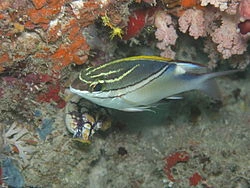
Here I will let you know some synonyms for this fish.
I am pleased to provide you with the Latin names:
Anthias bilineatus, Scalopsis bilineatus, Scolopsis bilineatus, Lutjanus ellipticus, Scolopsis bleekeri, Perca frenata, Pentapodus frenatus
Do you want to know some interesting facts?
To begin with, this fish glows (also known as fluorescence), which is fascinating.
In other words, when exposed to blue or ultraviolet light, the light emitted appears green.
However, under normal bright white light, only the stripes on the upper front part are visible.

I also give you a short description.
- The head and back of these fish are dark gray.
- The dark area is divided from the (almost complete) white body by a black-edged white band.
- A white spot is also found under the rear dorsal fin, as well as three yellow stripes on the head.
- The average length is 13 cm, while the maximum length is 25 cm.
Next, there are some names from all over the world.
- Australia: Bridled monocle bream, Bridled spine-cheek, Double lined coral bream, Two-line monocle bream, Yellow-finned spine-cheek
- China: 双带赤尾冬, 双线眶棘鲈, 雙線眶棘鱸
- Christmas I.: Bridled spinecheek
- Denmark: Dobbeltlinjet monokelbrasen
- Estonia: Särp-luupkala, Särp-skoloop
- Fiji: Mamau
- France: Mamila griffée, Scolopsis à deux lignes
- Guam: Twoline spinecheek
- India: Kolkodindan, കൊല് കൊടിണ്ടന്, കോല് കൊടിന്ദന്
- Indonesia: Aoloumang, Buarmata, Ija puti, Monocle bream, Sidemo karang, Two lined monode bream
- Japan: Futasiji-tamagashira
- Malaysia: Batu, Beliak mata, Bridled monocle bream, Bulat, Ikan bulat, Kerisi, Kerisi bali, Mempasir, Mentimun, Monocle bream, Pasir-pasir, Pasir-pasir dua-garis, Pijat-pijat, Puyu laut, Timun, Timun-timun, Two-lined monocle bream
- Maldives: Kiru bodahandhi, Poisson-virgule
- Micronesia: Galengaay, Twoline spinecheek
- Papua New Guinea: Bridled monocle bream, Two-line monocle-bream, Unanatokite, Wonano
- Philippines: Asoos, Baho-ulo, Bisugo, Bridled monacle bream, Buklid, Bullat, Bumba, Buruba, Lagao, Lagaw, Letekan, Palpagon, Ponong, Pugapu, Sablay, Silay, Sili, Siri, Suyong, Tagisang lawin, Taragaw, Tingin, Tonong, Two-line monocle bream, Two-lined monocle bream
- Spain: Besugato rayado
- Taiwan: 雙帶赤尾冬
- Thailand: Pla sai khao, Pla sai khao lai song sen, ปลาทรายขาวลายสองเส้น
- Timor-Leste: Bridled monocle bream, Chapaku api, Ikan fatuk, Kase
- Viet Nam: Cá Tráo trác hai sọc
I am going to show you some pictures here.
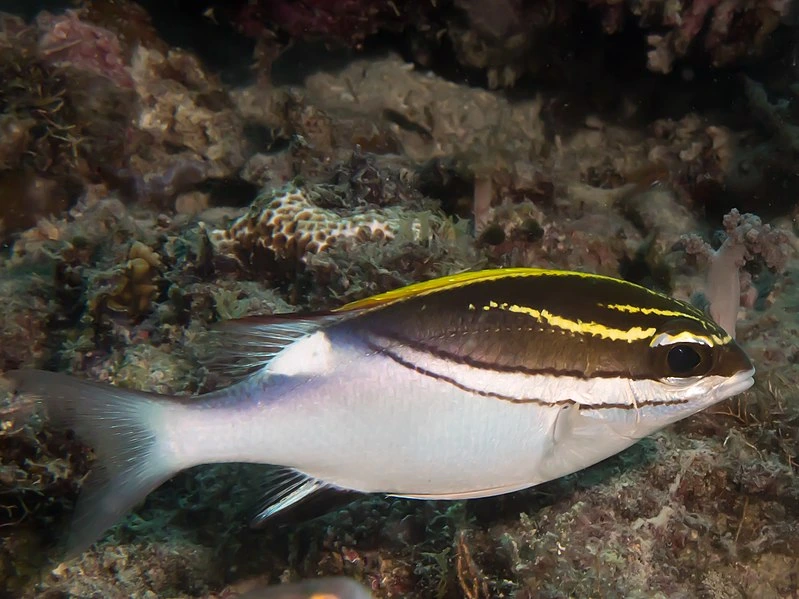
Rickard Zerpe, CC BY 2.0 https://creativecommons.org/licenses/by/2.0, via Wikimedia Commons
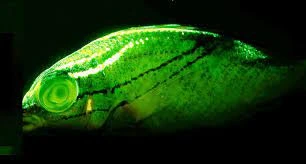

Here is another a video clip
Further, this fish can be found in :
- Firstly: in the Indian Ocean and the Western Pacific.
- Secondly: the majority of them live in coral reefs
- Thirdly: at depths ranging from 1 to 25 m
These animals can be found in the following fantastic countries:
- Asia: Andaman Is., Brunei Darsm, Cambodia, Chagos Is., China, Christmas I., Hong Kong, India, Indonesia, Japan, Macau, Malaysia, Maldives, Myanmar, Philippines, Ryukyu Is., Singapore, Sri Lanka, Taiwan, Thailand, Timor-Leste, Viet Nam
- Oceania: Australia, Fiji, Guam, Lord Howe I., Marshall Is., Micronesia, New Caledonia, North Marianas, Palau, Papua New Guinea, Solomon Is., Tonga, Vanuatu
But what do they eat?
Also, maybe you want to know what they eat.
As these fish are carnivores, they eat smaller fish and benthic animals.
In the meantime, how do those fish mate?
- Fish of this type are protogynous, which is unusual.
- As a result, this animal functions as a female first and then as a male later on.
- When it’s time to mate, the fertilization takes place externally.
So, do you think people eat fish like this?
Local people often seek out this species for food. They can also be found in the aquarium trade.
Last but not least, are they in danger?
Fortunately, I can state that the Scolopsis bilineata is not endangered.
Thirdly: Scolopsis ciliata (Saw-jawed monocle bream)
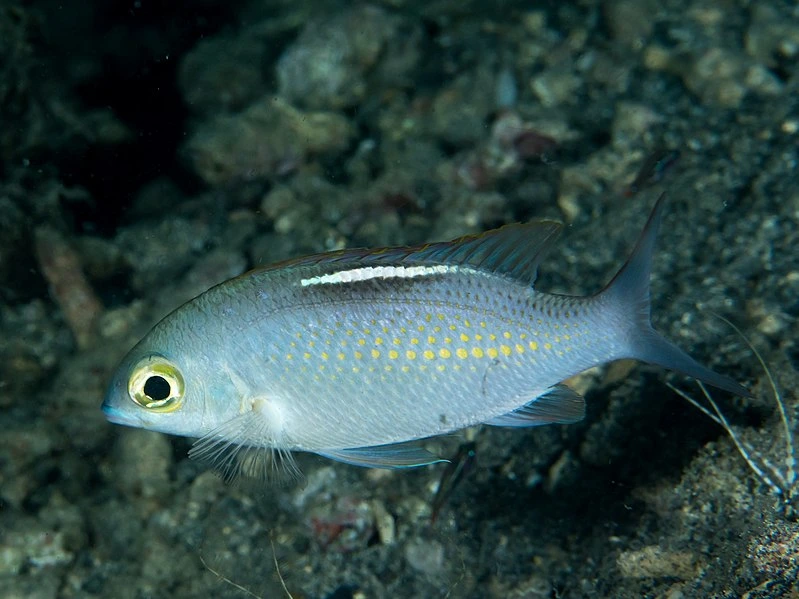
Rickard Zerpe, CC BY 2.0 – https://creativecommons.org/licenses/by/2.0 -, via Wikimedia Commons
Here I will let you know some synonyms for this fish.
I am pleased to provide you with the Latin names:
Holocentrus ciliatus, Scolopsis ciliatus, Scolopsis ciliates, Scolopsis lycogenis, Lycogenis argyrosoma, Scolopsis specularis, Scolopsis luzonia
Also known as:
Ciliate spinecheek, Coral Bream, Monocle Bream, Sawjaw monocle bream, Sawjaw spinecheek, Saw-jawed Monocle bream, Saw-jaw Monocle Spinecheek, Silverline Spinecheek, Spinecheek, Whiptail, Whitestreak Spinecheek, White-striped Monocle Bream.
Do you want to know some interesting facts?
Like all other scolopsis species, this fish also has excellent vision.
In its search for prey, it swims just above the bottom, where it can stop quickly before taking off again.
I also give you a short description.
- The top part of the animal is olive-colored, and the underside is white.
- There are also yellow spots from the pectoral fin to the caudal peduncle.
- Coupled with yellow spots that are spread from the pectoral fin to the caudal peduncle.
- Exceptionally, the upper and lower edges of the caudal fin are reddish.
- The average length is 10 cm, while the maximum length is 25 cm.
Next, there are some names from all over the world.
- China: 黄点赤尾冬, 齒頜眶棘鱸, 齿颌眶棘鲈
- Denmark: Savkæbet monokelbrasen
- France: Scolopsis à taches orange
- Guam: Ciliate spinecheek
- India: Monocle bream
- Indonesia: Ija putilo ote, Kapa-kapa, Silver-line spinecheek, Tintah bonda, Tonto
- Japan: Hakusen-tamagashira
- Malaysia: Batu, Beliak mata, Bulat, Kerisi, Mempasir, Mentimum, Monocle bream, Pasir-pasir, Pasir-pasir garis atas putih, Pijat-pijat, Puyu laut, Saw-jawed monocle bream, Timun, White-striped monocle bream
- Micronesia: Ciliate spinecheek
- Papua New Guinea: Matabibi, Saw-jawed monocle-bream
- Philippines: Baho-ulo, Bisugo, Buklid, Bumba, Buruba, Lagaw, Letekan, Monocle bream, Pugapu, Punong, Sagisi-on, Silay sa bato, Silp, Siri, Tagisang lawin, Taragaw, Tingin, Tunong, Whitestreak monocle bream
- Taiwan: 黃點赤尾冬
- Thailand: Pla sai khao, Pla sai khao lang thab, Pla sai khaow lang thab, ปลาทรายขาวหลังแถบ
- Viet Nam: Cá Dơi hàm có răng nhỏ
I am going to show you some pictures here.
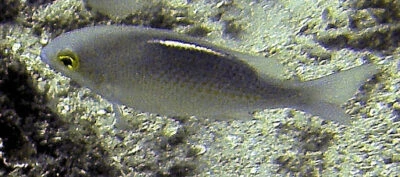
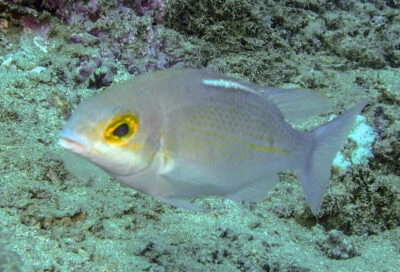
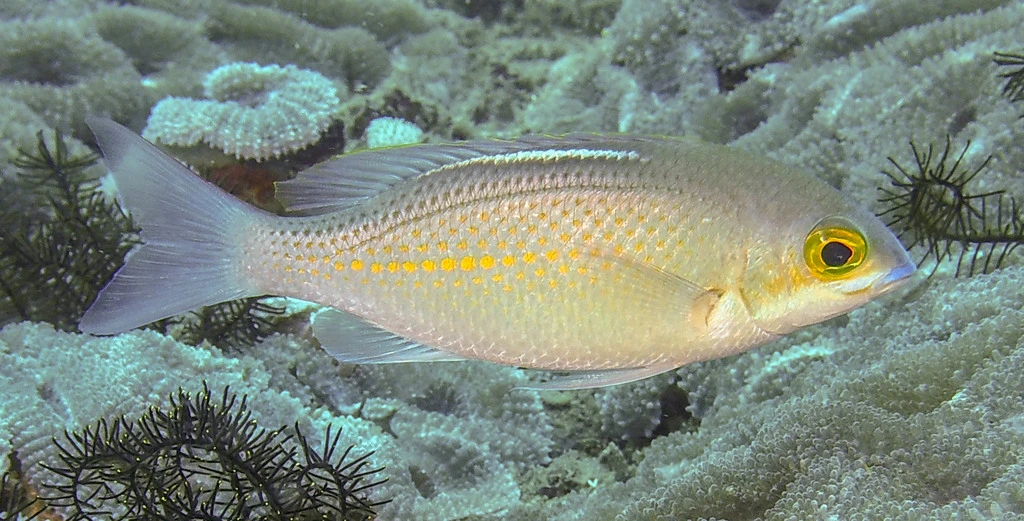
Further, this fish can be found in :
- Firstly: these fish are native to the Indian and Pacific Oceans. Known are: Ryukyu Islands, Andaman Sea, Indonesia, Philippines, Soloman Islands, and Vanuatu.
- Secondly: they like to swim around in small schools.
- Thirdly: they swim in seawater and are especially close to coral reefs.
- Fourthly: they are mainly found at a depth of 2 – 25 m.
These animals can be found in the following fantastic countries:
- Asia: Andaman Is., Brunei Darsm, Cambodia, China, Hong Kong, India, Indonesia, Japan, Macau, Malaysia, Myanmar, Philippines, Ryukyu Is., Singapore, Taiwan, Thailand, Timor-Leste, Viet Nam
- Oceania: Micronesia, New Caledonia, Palau, Papua New Guinea, Solomon Is., Vanuatu
But what do they eat?
In addition, perhaps you would like to know what they eat?
Above all, their meal includes worms, small fish, benthic invertebrates, and benthic crustaceans.
Last but not least, are they in danger?
Fortunately, I can state that the Scolopsis ciliata is not endangered.
Fourthly: Scolopsis margaritifera (Pearly monocle bream) (G.Cuvier, 1830)
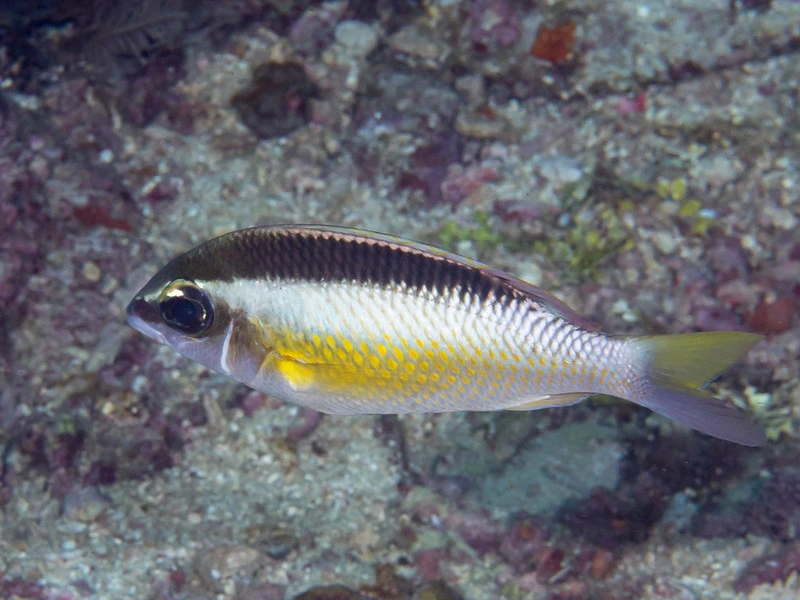
Do you want to know some interesting facts?
Like the rest of the scolopsis species, this fish also has excellent vision. It swims just above the bottom where they can stop for prey at lightning speed and immediately take off again.
Here I will let you know some synonyms for this fish.
I am pleased to provide you with the Latin names:
Scolopsides margaritifer, Scolopsis margaritifer, Scolopsides pectinatus, Scolopsides leucotaenia, Scolopsis leucotaenia, Scolopsides leucotaenioides, Scolopsis macrophthalmus.
Also, some people will know these synonyms:
Margarite’s spinecheek, Bared-face spinecheek, Spinecheek, Blue-and-yellow monocle bream, Whiptail, Coral Bream, Pearly spinecheek, Rainbow bream, Monocle bream.
I also give you a short description.
- This animal is mainly gray-green-colored on top, and rather pale white at the bottom
- Furthermore, their scales are pearly white and marked with white vertical lines.
- On the side, the scales have yellow spots and form longitudinal lines.
- Remarkable: on their snout they have a bluish line just in front of the eyes.
- The average length is 15 cm, while the maximum length is 28 cm.
Next, there are some names from all over the world.
- Australia: Pearly monocle bream, Pearly spine-cheek
- China: 条纹赤尾冬, 珠斑眶棘鱸, 珠斑眶棘鲈, 白条眶棘鲈, 白條眶棘鱸, 红尾冬仔
- France: Scolopsis nacré
- Guam: Margarite’s spinecheek
- Indonesia: Pasir manuk, Pearly spinecheek, Sero malam, Tintah iga buku, Wai-wai
- Malaysia: Barned-face spine-cheek, Batu, Beliak mata, Blue and yellow monocle bream, Bulat, Ikan bulat, Kerisi, Mempasir, Menpasir, Mentimun, Monocle bream, Pasir-pasir, Pasir-pasir mutiara,Pearly monocle bream, Pearly spine-cheek, Pijat-pijat, Puyu Laut, Rainbow bream, Timun
- Micronesia: Pearly spinecheek
- Papua New Guinea: Degari, Pearly monocle-bream
- Philippines: Bumba, Buruba, Katambak, Letekan, Pearly monocle bream, Pugapu, Silay, Tagisang lawin, Taragaw
- Taiwan: 條紋赤尾冬
- Viet Nam: Cá Tráo mat-ga
I am going to show you some pictures here.

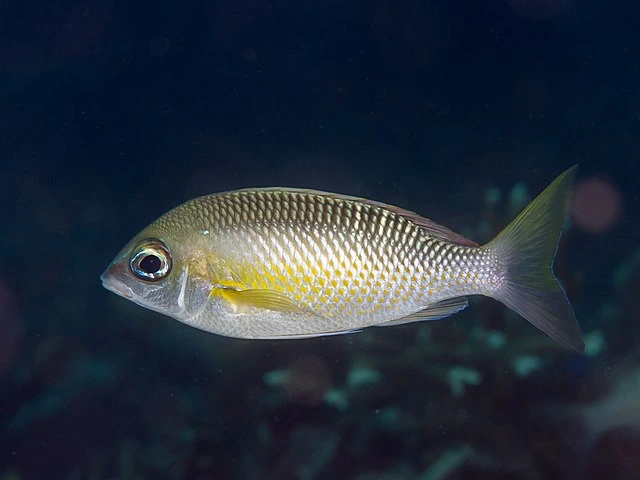

Further, this fish can be found in :
- Firstly: such beautiful fish are native to the western Pacific Ocean.
- Secondly: this fish can also be found near coral reefs
- Thirdly: at a depth range of 2-25 m.
These animals can be found in the following fantastic countries:
- Asia: Brunei Darsm, Cambodia, China, Indonesia, Malaysia, Philippines, Singapore, Taiwan, Thailand, Timor-Leste, Viet Nam
- Oceania: Australia, Palau, Papaua New Guinea, Solomon Is., Vanuatu
But what do they eat?
You may also want to know what they eat?
Particularly their meal includes worms, small fish, mollusks, benthic invertebrates, and benthic crustaceans.
Last but not least, are they in danger?
Fortunately, I can state that the Scolopsis margaritifera is not endangered.
Brief outline of different types of which little is known.



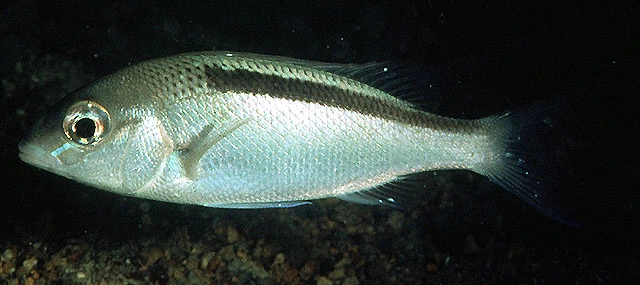
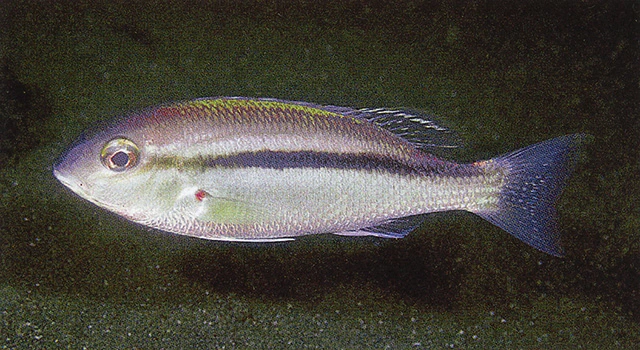
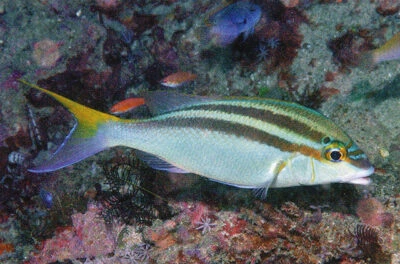
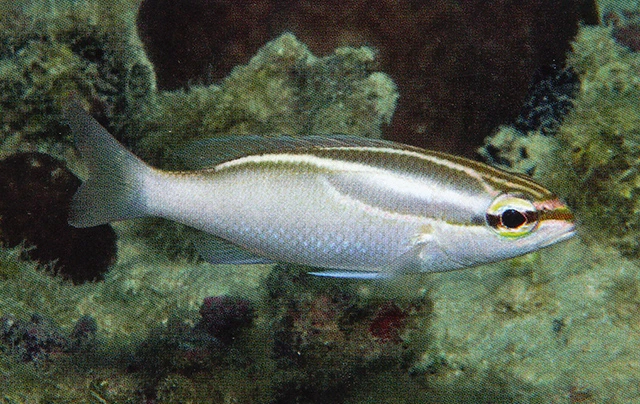
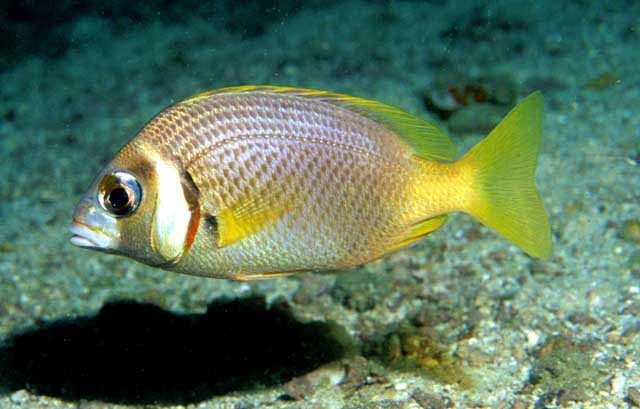


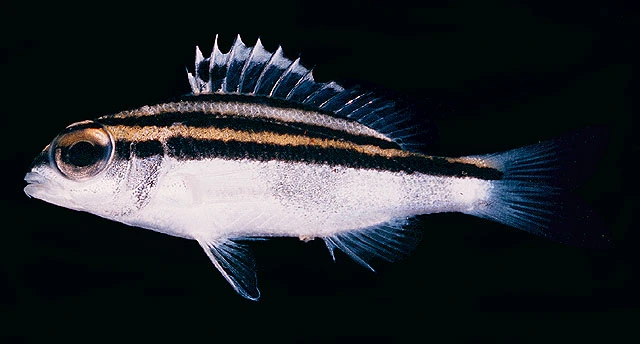
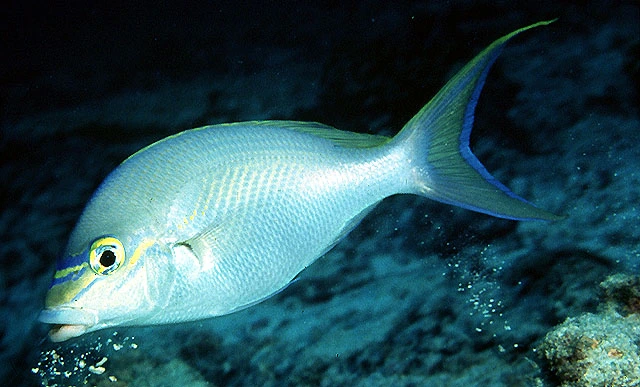
I have not tracked down any photos of these species
- Scolopsis igcarsensis (Igcar monocle bream): Mishra, S.Biswas, B. C. Russell, Salpathy & Selvanyagam, 2013
- Scolopsis lacrima (Teary monocle bream): Nakamura, Béarez & Motomura, 2019
- Scolopsis meridiana (Sahul monocle bream): Nakamura, Russell, Moore & Motomura, 2018
Finally
This is where I come to the end of this article. I hope you found it interesting and of course, any questions, additional information, comments, ambiguities, or untruths can always be left behind. Thanks in advance!